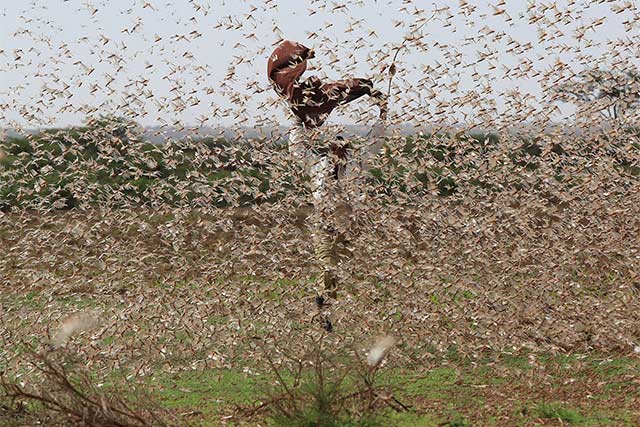Embrace Alternative Methods of Eradicating Desert Locusts

The second wave of the desert locust invasion is expected, scientists have warned. The ongoing March to May rainfall season is conducive for hatching hence the locusts will multiply by June this year.
“Breeding continues in the Horn of Africa, which will cause locusts to increase further in Ethiopia, Somalia and Kenya with new swarms forming in March and April,” explains the United Nations Food and Agriculture Organization (UN FAO) in a forecast statement http://www.fao.org/ag/locusts/en/info/info/index.html
According to the forecast, locust swarms have started laying eggs and another generation of breeding will increase locust numbers.
“Urgent efforts must be made to stop them from increasing to protect farmers and livestock holders,” said Keith Cressman, a senior locust forecasting officer at the FAO.
This poses a threat to food security, pasture and livelihood in a region recently devastated by climate change shocks, and the coronavirus.
Experts believe climate change is responsible for the invasion of the desert locust in the region. According to Stephen Njoka, the director general of the Desert Locust Control Organisation for Eastern Africa, climate change could be behind this invasion.
“The current rains in Kenya are very unusual, making vegetation available to the pests and creating suitable egg laying sites in the soil,” he explains.
He says that aerial and ground spraying with safe pesticides, such as insecticidal petroleum or plant-based oils, are the best ways to control the locust invasion.
The FAO, has more than doubled its desert locust funding appeal to $153.2 million from $70 million initially. They have so far received $22 million to assist the five countries initially affected.
Environmental impact of pesticides
According to the FAO, the coronavirus pandemic has an impact on the supply of pesticides as well as motorized sprayers because of delays in pesticide deliveries. The delays are caused by the reduction in global air freight operations. In February 2020, the FAO trained over 300 National Youth Service trainees to boost the Government of Kenya’s surveillance and control of the desert locust invasion.
According to Dr. Saliou Niassy, head of the Technology Transfer Unit at the International Centre of Insect Physiology and Ecology (ICIPE), the use of pesticides to control locusts is a source of concern. He says that the pesticides might have devastating effects on other beneficial insects such as bees, green lacewings, and dragonflies, which balance the ecosystem.
He also noted that the pesticides may lead to contamination of water surfaces such as rivers and lakes.
“Pesticide contaminated water poses a great threat to aquatic life. It can affect aquatic plants, decrease dissolved oxygen in the water and cause physiological and behavioral changes in fish populations,” he explains.
Alternative solutions
To protect such species that are not targeted, Dr. Niassy advises that such areas should not be sprayed and an alternative method should be used.
Vulnerable countries such as Kenya, are advised to use remote sensing technology and ground surveys to identify and eliminate locust breeding areas.
Other control measures being tested to detect swarms through special sensors include the use of drone technology. Drone technology could provide survey and control teams with an inexpensive and efficient method of searching for these destructive insects. It has however not been done before, so this will be a learning process.
“Nobody has ever done this with desert locusts. So we have no proven methodology for using drones for spraying locusts,” says Cressman.
Cressman also encourages the regular monitoring of the locusts. “The successful prevention of desert locust relies on regular monitoring in the desert, early warning, and timely response. If a local plague is not detected in time it has devastating effects on local livelihoods.”
Further, locusts are a delicacy in many African, Middle Eastern, and Asian countries. They have been used as food throughout history. Dr. Muo Kasina, chairman of the Entomological Society of Kenya said the locusts are rich in proteins. “These locusts are edible and besides the aerial spray that the government is doing, people should start harvesting them and eat them with ugali. They are rich in proteins which is a constraint in the country,” Muo said.
Dr. Muo also recommends the use of desert locust in animal feed. He says that among the many ingredients required to make animal feed are maize and a source of protein. By using desert locust as a source of protein, manufacturers will save a lot of money.
What journalists should do:
- Find out the environmental impact of using spraying as a method of controlling the desert locusts.
- Find out some of the control measures that have been used in other regions successfully without use of sprays.
- Find out the level of preparedness in the country to eliminate locusts amid the coronavirus pandemic.
- Find out the economic loss caused by the locusts during the first wave of attack, and the projected loss in the second wave.
- Journalists willing to further pursue this story would want to establish how Kenya and other countries handled the outbreak before.
By George Achia
I needed to thank you for this great read!! I absolutely enjoyed
every little bit of it. I have you book-marked to check out new stuff you post…